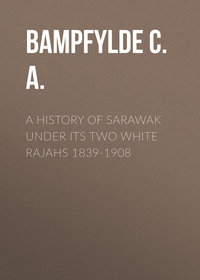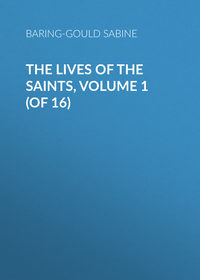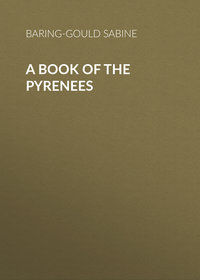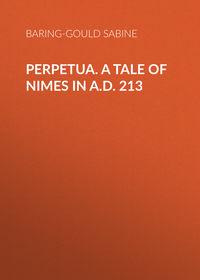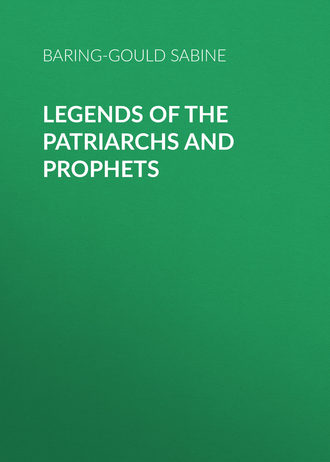 полная версия
полная версияLegends of the Patriarchs and Prophets
The prophet announced to the priests and wise men of Egypt that when a virgin, who had borne a son, should set her foot on Egyptian soil, all the idols should fall.
Before the destruction of Jerusalem, he hid the ark of the covenant in a rock, which opened for the purpose, and closed upon it. Then said he to the princes of the people and to the elders, “The Lord has gone up from Sinai, but He will come again with His sacred power. And this shall be the token of His coming, – all nations shall bow before the Wood.”
Then the prophet continued, “None of the priests and prophets shall open the ark, except Moses, the elect of God; and Aaron shall alone unfold the tables it contains. At the Resurrection, the ark shall arise out of the rock first of all, and it shall be placed upon Mount Zion. Then all the saints will go there and await the Lord, and they will put the enemy to flight who seeks their destruction.”
Having said these words, he traced with his finger the name of God upon the rock, and the name remained graven there as if cut with iron. Then a cloud descended upon the rock and hid it, and no man has seen it since. It is in the desert, amongst the mountains, where are the tombs of Moses and Aaron. At night a cloud of fire shines above the spot.
XLII
EZEKIEL
Ezekiel, whom the Arabs call Kazquil, was the son of an aged couple, who had no children. They prayed to God, and He gave them a son.
Ezekiel was a prophet, and he exhorted the men of Jerusalem to war, but they would not go forth to battle. Then God sent a pestilence, and there died of them every day very many. So, fearing death, a million fled from the city, hoping to escape the pestilence, but the wrath of God overtook them, and they fell dead.
Then those who survived in the city went forth to bury them, but they were too numerous; therefore they built a wall round the corpses, to protect them from the beasts of the field; and thus they lay exposed to the heat and cold for many years, till the flesh had rotted off their bones.
Once the prophet Ezekiel came that way, and he saw this great multitude of dead and dry bones. He prayed, and God restored them to life again, and they stood upon their feet a great army, and entered into the city, and lived out the rest of their days. It is said that among the Jews there are, to this day, descendants of those who were resuscitated, and they may be recognized by the corpse-like odor they exhale.697
The Jews relate that a celebrated Rabbi found the greatest difficulty in comprehending the book of Ezekiel; therefore his disciples prepared for him three hundred tuns of oil to feed his lamp whilst he studied at night the visions of the prophet698
XLIII
EZRA
Cyrus, in the year 537 before Christ, put an end to the captivity of the Jews in Babylon, as had been foretold by Daniel; and not only did he permit the Jews to return to Jerusalem, but he furnished them with the means of rebuilding their city and temple. The Oriental writers, to explain the motive of Cyrus, say that his mother was a Jewess, and that he himself was married to the Jewess Maschat, sister of Zerubabbel, a granddaughter of the king Jehoiakim.
In 523 before Christ, Cambyses, having reigned a brief time, was succeeded by Smerdis, the Magian, who is called, in the Scriptures, Artaxerxes. He, being ill-disposed towards the Jews, withdrew from them the gifts made by Cyrus, and arrested their work. Smerdis, however, reigned only two years, and was succeeded by Darius Hystaspes, who continued the work of Cyrus, by the hands of Ezra or Esdras, one of the instruments used by God to restore His people.
Ezra was the son of Seraiah, of the lineage of Aaron.
In the Koran699 it is said that Ezra, passing through a village near Jerusalem, whose houses were ruined, exclaimed, “Can God restore these waste places, and revive the inhabitants?”
Then God made him die; and he remained dead for one hundred years. At the end of that time God revived him, and he saw the village rebuilt and full of busy people.
The commentators on the Koran say that Ezra (Ozaïr), when young, had been taken away captive by Nebuchadnezzar, but that he was delivered miraculously from prison, and returned to Jerusalem, which he found in ruins. He halted at a village, near the city, named Sair-Abad. Its houses were fallen and without inhabitants, but the fig-tree and vines remained in the gardens. Ezra collected the fruit, and made himself a little cell out of the fallen stones. And he kept near him the ass on which he had ridden.
The holy man, on contemplating from his hermitage the ruins of the holy city and the temple, wept bitterly before the Lord, and said often with a tone rather of lament than doubt, “How can the walls of Jerusalem ever be set up again?”
Then God bade him die, and hid him from the eyes of men, in his cell, with all that he had about him, his fruit, his mat, and his ass. At the close of a century God revived him, and he found all as when he had died; the ass standing, and the fruit unwithered. Then Ezra saw the works that had been executed in Jerusalem, how the walls were being set up, and the breaches repaired, and he said, “God is Almighty; He can do whatsoever pleaseth him!”
After his resurrection, he went into the holy city, and spent night and day in explaining to the people the Law, as he remembered it. But it had been forgotten by the Jews, and therefore they disregarded his instruction.
The Iman Thalebi says, that the Jews, to test the mission of Ezra, placed five pens in his hand, and with each he wrote at the same moment with like facility as if he held only one; and he wrote all the Books of the Sacred Canon, as he drew them from his memory, without the assistance of a book.
The Jews, however, said amongst themselves, “How can we be sure that what Ezra has written is the true sacred text, since there is none amongst us who can bear witness?”
Then one of them said, “I have heard say that my grandfather preserved a copy of the sacred books, and that they were hidden by him in a hollow rock, which he marked so that it might be recognized again.”
They therefore sought the place which had been marked, and there they found a volume containing the Scriptures, which having been compared with what Ezra had written, it was found that the agreement was exact. Then the people, astonished at the miracle, cried out that Ezra was a god.700
At the time of carrying away into Babylon, the sacred fire had been cast into a well in the temple court. Ezra, having drawn some of the dirt out of the well, placed on it the wood of the sacrifice; then the flame, which for a hundred and forty years had been extinguished, burst forth again out of the mire. When Ezra saw this wonder, he thrice drank of the dust out of the well; and thus he imbibed the prophetic spirit, and the power of recomposing from memory the lost sacred books.701
XLIV
ZECHARIAH
Sozomen702 relates that the prophet Zechariah appeared to Colomeras, a farmer of the village of Chupher, in Palestine, and revealed to him his tomb; and on excavations having been made on the spot, an ancient Hebrew book was discovered, which, however, was not regarded as canonical. Nicephoras repeats the story after Sozomen.703
1
Rev. xii. 7-9.
2
Isaiah xiv. 13, 14.
3
Luke x. 18.
4
Fabricius (J. A.), Codex Pseudepigraphus Vet. Test. Hamb., 1722, p. 21.
5
Jalkut Rubeni, 3, sub. tit. Sammael.
6
Fol. 139, col. 1: see Eisenmenger, i. p. 831.
7
Jalkut Rubeni, in Eisenmenger, i. p. 307.
8
Eisenmenger, i. p. 104.
9
Ibid., i. p. 820.
10
Ibid., ii. 416, 420, 421.
11
Chronique de Tabari. Paris, 1867, i. c. xxvii.
12
Abulfeda, Hist. Ante-Islamica. Lipsiæ, 1831, p. 13.
13
1 Cor. x. 20.
14
Majer, Mythologische Lexicon, Th. i. p. 231.
15
Orig. adv. Cels. vi. 42.
16
Lettres Edifiantes, viii. p. 420.
17
Bibliothèque Univ. de Genève, 1827; D’Anselme, i. p. 228.
18
Hist. Naturelle de l’Orinoque, par Tos. Gumilla. Avignon, 1751, t. i. p. 172.
19
Weil, Biblische Legenden der Muselmänner. Frankfort, 1845, pp. 12-16.
20
Geiger, Was hat Mohammed aus d. Judenthum aufgenommen? p. 99.
21
So also Abulfeda, Hist. Ante-Islamica, ed. Fleischer. Lipsiæ, 1831 p. 13.
22
Tabari, i. c. xxvi.
23
Colin de Plancy, p. 55.
24
Eisenmenger, Neuentdecktes Judenthum. Königsberg, 1711, i. pp. 364-5.
25
Bochart, Hierozoica, p. 2, l. 8, fol. 486.
26
Tract Sanhedrim, f. 38.
27
Jalkut Schimoni, f. 6.
28
Tract Hagida, f. 12.
29
Eisenmenger, i. p. 367.
30
Ibid., 368.
31
Eisenmenger, i. p. 369.
32
Müller, Amerikanische Urreligionen; Basle, 1855. Atherne Jones, North American Traditions, i. p. 210, etc. Heckewelder’s Indian Nations, etc.
33
Fourmont Anciens Peuples, i. lib. ii. p. 10.
34
Aves, 666.
35
Mémoires des Chinois, i. p. 105.
36
Berosus, in Cory’s Ancient Fragments, p. 26.
37
It is unfortunate that I have already written on the myths relating to the formation of Eve in “Curiosities of Olden Times.” I would therefore have omitted a chapter which must repeat what has been already published, but that by so doing I should leave this work imperfect. However, there is much in this chapter which was not in the article referred to.
38
Rabboth, fol. 20 b.
39
Eisenmenger, i. 830.
40
Weil, pp. 17, 18.
41
Tabari, i. c. xxvi.
42
Talmud, Tract. Berachoth, f. 61; Bartolocci Bibl. Rabbin., iv. p. 66.
43
Bartolocci, Bibl. Rabbin., iv. p. 67.
44
Bartolocci, Bibl. Rabbin., iii. p. 395.
45
Ibid., p. 396; Eisenmenger, t. i. p. 365.
46
Bhagavat, iii. 12, 51.
47
Colebrooke Miscell. Essays, p. i. 64.
48
Bundehesch, p. 377.
49
Bartolocci, Bibl. Rabbin., iv. p. 463.
50
Mendez Pinto, Voyages, ii. p. 178.
51
Bhagavat, iii. 12, 25.
52
Ibid., iv. 15, 27.
53
Ovid, Metamorph., x. 7.
54
Hesiod, Works and Days, 61-79.
55
Gen. i. 27.
56
Ibid., ii. 18.
57
Ibid., 23.
58
Abraham Ecchellensis, Hist. Arabum, p. 268.
59
Talmud, Tract. Bava Bathra.
60
S. Epiphan. Hæres., xxvi.
61
Tho. Bangius, Cœlum Orientis, p. 103.
62
S. Clementi Recog., c. iv.
63
Lafitau, Mœurs des Sauvages Amériquaines, i. p. 93.
64
Pallas, Reise, i. p. 334.
65
Hodgson, Buddhism, p. 63.
66
Upham, Sacred Books of Ceylon, iii. 156.
67
Mémoires Chinois, i. p. 107.
68
Bundehesch in Windischmann: Zoroastrische Studien. Berlin, 1863, p. 82; and tr. A. du Perron, ii. pp. 77-80.
69
So also Abulfeda, Hist. Ante-Islamica, p. 13.
70
Weil, pp. 19-28.
71
Tabari, i. p. 80.
72
Diod. Sicul., 14 et seq.
73
Ausland für Nov. 4, 1847.
74
W. Smith, Nouveau Voyage de Guinée. Paris, 1751, ii. p. 176.
75
Bowdler, Mission from Cape Coast to Ashantee. London, 1819, p. 344.
76
Cranz, Historie von Grönland. Leipzig, 1770, i. p. 262.
77
Humboldt, Pittoreske Ansichten d. Cordilleren; Plate xiii. and explanation, ii. pp. 41, 42.
78
De la Borde, Reise zu den Caraiben. Nürnb. 1782, i. pp. 380-5.
79
Allg. Hist. der Reisen, xviii. p. 395.
80
Eisenmenger, i. pp. 827-9.
81
Weil, p. 28.
82
Basnage, Histoire des Juifs. La Haye, iii. p. 391.
83
Tract. Avod., f. 1. col. 3; also Tract. Pesachim, f. 118, col. 1.
84
Eisenmenger, i. pp. 376, 377.
85
Eisenmenger, i. pp. 377-80.
86
Talmud, Avoda Sara, fol. 8 a, and in Levy, Parabeln, p. 300.
87
It is a popular superstition among the lower orders in England that a woman who dies in childbirth, even if she be unmarried, cannot be lost.
88
Weil, pp. 29-38.
89
Dillman, Das Adambuch des Morgenlandes; Göttingen, 1853. This book is not to be confounded with the Testament of Adam.
90
Tabari, i., capp. xxviii. xxix.
91
In More Nevochim, quoted by Fabricius, i. p. 5.
92
Gen. v. i.
93
Fabricius, i. p. 11.
94
Adv. Hæresi, c. 5.
95
Eusebius Nierembergius, De Origine S. Scripturæ. Lugd., 1641.
96
Fabricius, i. p. 33.
97
Ferdinand de Troilo, Orientale Itinerario. Dresd., 1667, p. 323.
98
Selden, De Synedriis, ii. p. 452.
99
Hottinger, Historia Orientalis, lib. i. c. 8.
100
Jacobus Vitriacus, Hist. Hierosol., c. lxxxv.
101
As King Charles’s Oak may be seen in the fern-root.
102
Fabricius, i. p. 84.
103
Neue Ierosolymitanische Pilgerfahrt. Würtzburg, 1667, p. 47.
104
Stephanus Le Moyne, Notæ ad Varia Sacra, p. 863.
105
Abulfeda, p. 15. In the Apocryphal book, The Combat of Adam (Dillman, Das Christliche Adambuch des Morgenlandes; Göttingen, 1853), the same reason for hostility is given. In that account, Satan appears to Cain and prompts him to every act of wickedness.
106
Tabari, i. c. xxx.
107
Jalkut, fol. 11 a.
108
Yaschar, p. 1089.
109
Targums, ed. Etheridge, London, 1862, i. p. 172.
110
Eisenmenger, i. p. 320.
111
Liber Zenorena, quoted by Fabricius, i. p. 108.
112
S. Methodius, jun., Revelationes, c. 3.
113
Eutychius, Patriarcha Alex., Annales.
114
Pirke R. Eliezer, c. xxi.
115
Historia Dynastiarum, ed. Pocock; Oxon. 1663, p. 4.
116
Ad Antiochum, quæst. 56.
117
Fabricius, i. p. 112.
118
Eisenmenger, i. p. 462.
119
Targum, i. p. 173.
120
Jalkut Cadasch, fol. 6, col. i.
121
Pirke R. Eliezer, c. xxi.
122
Ibid.
123
Ibid.
124
Eisenmenger, ii. p. 8.
125
Ibid., p. 428.
126
Ibid., p. 455.
127
Tract. Avoda Sara.
128
Tabari, i. c. xix.
129
Antiq. Judæ., lib. i. c. 2.
130
Excerpta Chronologica, p. 2.
131
Gen. iv. 15.
132
Cosmas Indopleustes, Cosmographia, lib. v.
133
D’Herbelot, Bibliothèque Orientale, sub voce Cabil, i. p. 438.
134
Neue Ierosolymitanische Pilgerfahrt. Von P. F. Ignat. von Rheinfelden. Würtzburg, 1667. P. ii. p. 8.
135
Weil, pp. 40-3.
136
Tabari, i. c., xxxiii.
137
Colin de Plancy, p. 78.
138
Herbelot, i. p. 95.
139
Moses bar Cepha. Commentarius de Paradiso, P. i. c. 14. Fabricius, i. p. 75.
140
S. Basil Seleuc. Orat. xxxviii.
141
Lettre de H. A. D., Consul de France en Abyssinie, 1841.
142
Tabari, i. c. xxxiv.
143
D’Herbelot, i. p. 125, s. v. Rocail.
144
Midrash Tillim, fol. 10, col. 2.
145
Eisenmenger, i. p. 645.
146
Theodoret, Quæst. in Gen. xlvii.
147
Plutarch, Isis and Osiris, ed. Parthey; pp. 72, 88, and notes pp. 183, 238.
148
Abulfaraj, Hist. Dynast., ed. Pocock, p. 5.
149
Joseph. Antiq. Judaic., lib. i. c. 2.
150
Freculphus, Chron. lib. i. c. 12.
151
Anastasius Sinaita, Οδηγός. ed. Gretser, Ingolst. 1606, p. 269.
152
Gen. v. 6-9.
153
Pseudo Josephus Gorionides; ed. Clariss. Breithauptius, lib. ii. c. 18, p. 131.
154
I give the Arabic legend. The account in Jasher is different. Enoch retired from the world, and showed himself only at rare intervals, when he gave advice to all who came to hear his wisdom. He was taken up to heaven in a whirlwind, in a chariot with horses of fire. (Yaschar, pp. 1094-1096.)
155
Tabari, i. c. xxxv.
156
Dillman, Das Buch Enock; Leipzig, 1853. Ewald, in his “Geschichte der Volks Israel” (iii. 2, pp. 397-401), attributes it to the year 130. B. C.
157
Fol. 26, col. 2.
158
Jalkut Rubeni, fol. 27, col. 4.
159
Ibid., fol. 107, col i.
160
Targums, ed. Etheridge, i. p. 175.
161
Suidas, Lexic. s. v. Nannacos.
162
Nischmath Chajim, fol. 116, col. i.
163
Eisenmenger, i. p. 380.
164
Das Buch Henoch, von Dillmann, Leipz. 1853, c. xv. p. 9.
165
Abulfaraj, p. 6.
166
Eutych. Patriarcha Alex., Annales ab Orbe Condito, Arabice et Lat., ed. Selden; London, 1642, i. p. 19.
167
D’Herbelot, s. v. Surkrag and Kaïumarth.
168
Tabari, c. xxxvii.
169
D’Herbelot, s. v. Tahmourath.
170
Tabari, caps. xxxix. xl.
171
Gen. iv. 18-24.
172
Targums, ed. Etheridge, i. p. 173.
173
Yaschar, tr. Drach, p. 1092; the same in Midrash Jalkut, c. 38; Midrash, Par. Bereschith, fol. 2; Rabbi Raschi on Genesis; etc., etc.
174
Véland le Forgeron; Paris, 1833. There is an English translation by Wright.
175
Tabari, i. c. xxi.
176
Eisenmenger, ii. p. 416.
177
Colin de Plancy, p. 102.
178
Midrash, fol. 12; so also Targum of Palestine, Etheridge, i. p. 179.
179
Chron. Græc., ed. Scaliger, Lugd. Batav. 1606, p. 4.
180
Fabricius, i. p. 225.
181
Eisenmenger, i. p. 651.
182
Talmud, Tractat. Sanhedrin, fol. 108, col. 1. So also the Book Yaschar, p. 1097.
183
Jalkut, Genesis, fol. 14a.
184
Jalkut Shimoni, Job. fol. 121, col. 2.
185
Eisenmenger, i. p. 385. The Targum of Palestine says the water was hot (i. p. 179).
186
Tractat. Sevachim, fol. 113, col. 2.
187
Or, a unicorn; the Hebrew word is Reém.
188
Midrash, fol. 14.
189
Eutych, Patriarcha Alex., ed. Selden, i. p. 36.
190
Tabari, p. 108.
191
Abulfeda, p. 17.
192
Yaschar, p. 1100.
193
Colin de Plancy, p. 110.
194
Weil, p. 45.
195
Ararat.
196
Tabari, c. xli.
197
Weil, p. 45.
198
Midrash, fol. 15.
199
Tabari, p. 113.
200
Fabricius, i. pp. 74, 243.
201
Ed. Dillmann, c. 67.
202
Ed. Etheridge, i. p. 182.
203
Gen. v. 20.
204
In the Midrash Rabba, this want of connection between the name and the signification is remarked upon, and Solomon Jarki in his commentary says that, for the meaning assigned, the name ought to have been, not Noah, but Menahem.
205




